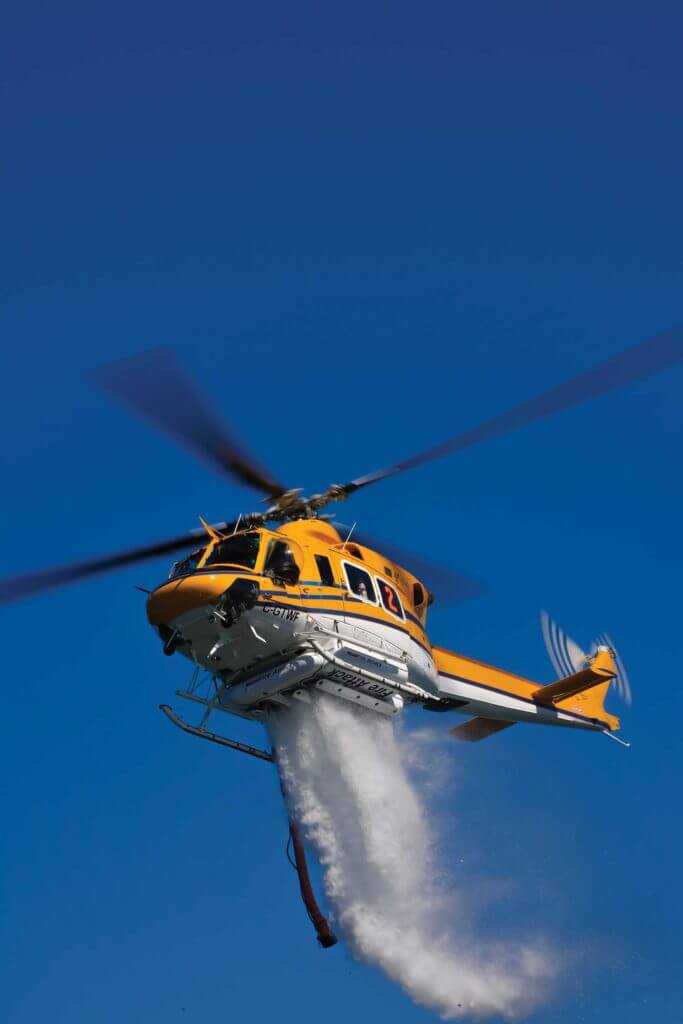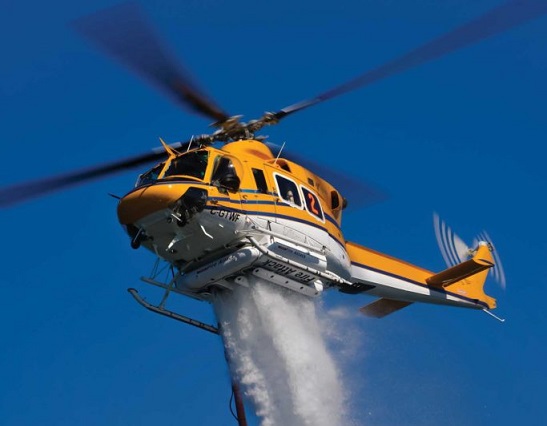Helicopters are pretty awesome devices. Even when you understand the physics of how they work, it’s still a wonder that the combination of whirling bits and pieces can result in flight. These magnificent machines put out fires, string powerlines, erect towers, pluck people in distress from mountains, and save countless lives. But here’s the thing: a brand new, factory-spec helicopter right off the production line can’t do any of those things. Flip through the pages of any issue of Vertical, and in almost every photo, the aircraft has been fitted with some type of special equipment.

A firefighting machine will have a cargo hook for the bucket, a bubble window, an external torque gauge, pulse lights and a mirror. A search-and-rescue aircraft will have a hoist. Air ambulances are filled with lifesaving equipment. And very little of that stuff comes directly from the airframe original equipment manufacturers (OEMs). Instead, this equipment is in place thanks to supplemental type certificates (STCs). As the name implies, an STC is required for an installation that supplements the original aircraft type certificate. It needs to meet all of the same requirements as the aircraft that it’s installed upon. Therefore, it must undergo the same kind of testing, analysis, and scrutiny that the aircraft does.
How do regulatory authorities ensure that supplementary equipment meets the same standards as the aircraft they’re designed to augment? Through people like me.
I am a Transport Canada Design Approval Representative (DAR), also known as a delegate. A DAR does not actually work for Transport Canada, but is delegated to act on its behalf to make findings of compliance in a particular field of specialty — such as structures, avionics, or as a flight test pilot.
To secure an STC, not only must a modification meet the same standards as the original aircraft, but it has to be shown not to degrade the safety of the aircraft. Let’s take the firefighting helicopter as an example. The bubble window needs to be strong enough to withstand the aerodynamic loads in flight. In order to verify this, a structural test can be done on a test rig. However, the bubble window protrudes from the aircraft, resulting in extra drag. It could adversely affect how the aircraft behaves, or reduce climb performance, or have an effect on the pitot-static system. These are the sorts of issues that flight testing is meant to uncover.

Similarly, if someone wants to upgrade an old GPS system to the latest and greatest model, testing must be done to ensure that there is no electrical interference between the new unit and any other existing systems on the aircraft.
A big part of the STC process is determining just how you can prove that a modification meets the regulations. Does it need to be tested or is a stress analysis enough? Or is it a combination of the two — or another method entirely? And on top of that, which regulations are applicable? And furthermore, which version of the regulations needs to be applied? The rules for the Airbus H125, for example, are not the same as for the Bell 429. It’s the role of the DAR (with concurrence from the regulator, in my case Transport Canada) to make these kinds of determinations.
While the STC process is technically uniform, the scope can vary widely from one project to another. Changing a seat cushion or changing an engine type can both be STCs. The execution of a project can take many forms, and is dependent on a huge number of factors, including the DAR, the project scope, the resources available, and the end user.
In my current role, I work largely on my own. The process typically begins with me submitting an application to open the project with Transport Canada. I prepare the documents and drawings, and witness and document any required testing. Then I compile it all and submit it to Transport Canada. Through all this, I will rely
heavily on the end user to provide their insight and expertise — and their facilities. After all, it’s their aircraft, and they are the ones who will ultimately be installing, using, and maintaining the STC kit — so it has to make sense to them. Whenever possible, I will have documents and drawings reviewed by the maintenance team to make sure that theory and reality align.

Becoming a delegate
How does someone become a delegate? In Canada, it begins with an educational requirement. You must have an engineering degree, or have, in the opinion of Transport Canada, equivalent experience. In other words, if someone has many years of applicable experience, they can be eligible to be a delegate, even if they do not have an engineering degree.
A prospective delegate must also successfully complete the Aircraft Certification Specialty Course. This is a two-week intensive course that covers the ins and outs of aircraft certification: type certification, STCs, Change Product Rule and so on. And yes, there are exams!
Next is a one-year working relationship with Transport Canada. The process for becoming a delegate is not uniform, with the one-year timeline more of a guideline than a rule. In my case, it took less than 12 months. Prior to beginning my process, I had the good fortune of working for a talented delegate for many years. He taught me how it “should be done.” I was given the opportunity to fly at 170 knots indicated airspeed in AStars pointed at the ground during flight tests; I snapped bolts while piling steel plates onto structures during structural tests; and I wrote numerous
supporting reports for many kinds of STCs for many different aircraft types. My mentor is a (sometimes maddeningly) meticulous guy. Everything we did was thorough and correct. So, by the time I was presenting my own work to Transport Canada, it was evident that I already had a pretty firm grasp on the process. As a result, my delegation was granted before a full year.
During the period while I was building my relationship with Transport Canada, my friends would ask if I had to accomplish certain specified milestones or achieve specific “levels.” The short answer is: not really. In fact, it’s about building trust. It’s almost counter-intuitive that in an industry with such strict regulations, granting delegation to someone is, to a large degree, based on a “warm, fuzzy feeling.”

Ultimately, Transport Canada must have confidence in the delegate. Let’s face it, we are in a business with tight schedules and high price tags. There can be a lot of pressure, financial or otherwise, to meet deadlines — and things can go wrong. Parts can fail under ultimate loading during a structural test. That cursed Velcro can fail the flammability test. And when these things happen, it can be the delegate that incurs the wrath of the angry operator who really needs to get his aircraft flying. Transport Canada must have the confidence that not only does the delegate have the technical knowledge and ability, but that they have the intestinal fortitude to stand firm under what can sometimes be difficult circumstances.
There’s the somewhat cynical axiom that the only way for an aircraft to be 100 percent safe is to never let it fly. I have heard many tales of woe and misery about people’s dealings with Transport Canada and how the regulator was being “unreasonable” about X, Y, or Z. I’m of the opinion that these instances often stem from poor communication — on both sides. This is another area where the DAR can help.
The DAR often acts as a liaison (or translator) between the operator and Transport Canada. Operators don’t necessarily spend that much time studying design regulations. And similarly, Transport Canada engineers may not be fully familiar with the day-to-day challenges and obligations of aircraft operations. As a DAR, I speak the same language as Transport Canada. But I also spend a great deal of time in hangars, so I am also fluent in “aircraft operator.” This level of bilingualism can alleviate misunderstandings. And with a little strategic communication, everyone involved can be satisfied a lot sooner.
Not surprisingly, communication and open dialogue between the DAR and the regulator is just as crucial. It has been my experience that Transport Canada wants to help get projects completed. They are aviation geeks, just like the rest of us, and they want to “Git ‘er done.” Because I have developed a solid relationship with Transport Canada, if ever I find myself struggling with something, I can call them and ask for guidance. Obviously it’s not their job to fix the issue for me, but they are there to help. Whether they point me at an Advisory Circular that I wasn’t aware of, or they draw from their own experience, 99 times out of 100, talking it through with them yields a solution very quickly.

We all want to keep aircraft flying — safely. And we all have our different roles to play. As a DAR, I enjoy being the go-between for the regulatory world and the operational world. The challenge of getting them to work and play nicely together can be pretty fun — and a big part of accomplishing that goal requires earned trust and open communication.






While the STC process is technically uniform, the scope can vary widely from one project to another. Changing a seat cushion or changing an engine type can both be STCs. The execution of a project can take many forms and is dependent on a huge number of factors, including the DAR, the project scope, the resources available, and the end user.
When I went to check on STC application for the Transport Canada supposedly approved work platform attached to the side of a helicopter,
operated by Ontario Hydro, no STC could be found.
Shortly after the Hydro accident, Slave Lake Helicopters was in the process of seeking approval from TC for the same type of installation using the same kind of helicopter.
There is no reason that I can think of in this day and age that operators should be using single-engine helicopters around power lines.
At one time when the first twin-engined helicopters were being produced, when one engine quit it brought you to the scene of the accident, nowadays with the more powerful engines, you can fly away safely.
I have flown power lines in Quebec, Churchill Falls, Manitoba and worked for Ontario Hydro from Kenora and Thunder Bay.
ICAO states all operators shall have a Safety Management System (SMS) in place to have a license to operate, included is every modification to an aircraft should have a Risk Assessment carried out.
What role does a DAR provide or indicate to an operator when you stand in front of an AS350 with a work stand and a Tail Rotor in line from front to back?????
Just Asking!!